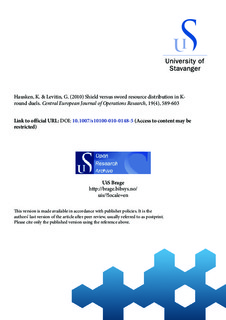Shield versus sword resource distribution in K-round duels
Journal article, Peer reviewed
Permanent lenke
http://hdl.handle.net/11250/184361Utgivelsesdato
2010-06Metadata
Vis full innførselSamlinger
Originalversjon
Hausken, K. & Levitin, G. (2010) Shield versus sword resource distribution in Kround duels. Central European Journal of Operations Research, 19(4), 589-603 10.1007/s10100-010-0148-5Sammendrag
The paper considers optimal resource distribution between offense and
defense in a duel. In each round of the duel two actors exchange attacks distributing
the offense resources equally across K rounds. The offense resources are expendable
(e.g. missiles), whereas the defense resources are not expendable (e.g. bunkers). The
outcomes of each round are determined by a contest success functions which depend
on the offensive and defensive resources. The game ends when at least one target is
destroyed or after K rounds. We show that when each actor maximizes its own survivability,
then both actors allocate all their resources defensively. Conversely, when
each actor minimizes the survivability of the other actor, then both actors allocate all
their resources offensively. We then consider two cases of battle for a single target
in which one of the actors minimizes the survivability of its counterpart whereas the
counterpart maximizes its own survivability. It is shown that in these two cases the
minmax survivabilities of the two actors are the same, and the sum of their resource
fractions allocated to offense is equal to 1. However, their resource distributions are
different. In the symmetric situation when the actors are equally resourceful and the
two contest intensities are equal, then the actor that fights for the destruction of its
counterpart allocates more resources to offense. We demonstrate a methodology of
game analysis by illustrating how the resources, contest intensities and number of
rounds in the duels impact the survivabilities and resource distributions.
Beskrivelse
The final publication is available at link.springer.com.
